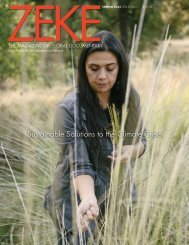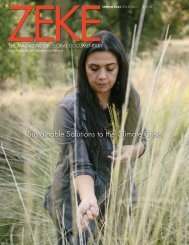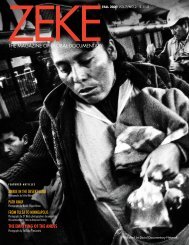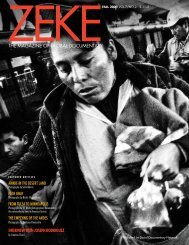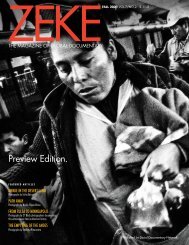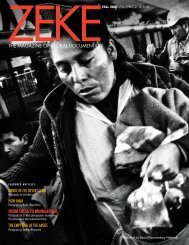ZEKE Fall 2019
Contents includes: "Youth of Belfast" by Toby Binder, and "Delta Hill Riders" by Rory Doyle, winners of ZEKE Award for Documentary Photography "Rising Tides" with photographs by Sean Gallagher, Lauren Owens Lambert, and Michael O. Snyder "Out of the Shadows: Shamed Teen Mothers of Rwanda" by Carol Allen Storey Interview with Lekgetho Makola, Head of Market Photo Workshop, South Africa, by Caterina Clerici "Why Good Pictures of Bad Things Matter" by Glenn Ruga Book Reviews and more...
Contents includes:
"Youth of Belfast" by Toby Binder, and "Delta Hill Riders" by Rory Doyle, winners of ZEKE Award for Documentary Photography
"Rising Tides" with photographs by Sean Gallagher, Lauren Owens Lambert, and Michael O. Snyder
"Out of the Shadows: Shamed Teen Mothers of Rwanda" by Carol Allen Storey
Interview with Lekgetho Makola, Head of Market Photo Workshop, South Africa, by Caterina Clerici
"Why Good Pictures of Bad Things Matter" by Glenn Ruga
Book Reviews and more...
- No tags were found...
Create successful ePaper yourself
Turn your PDF publications into a flip-book with our unique Google optimized e-Paper software.
TE AHI KA – : THE FIRES OF<br />
OCCUPATION<br />
By Martin Toft<br />
Dewi Lewis, 2018<br />
200 pages | £35.00<br />
“New Zealand’s Whanganui River<br />
granted legal status as a person<br />
after 170-year battle.”<br />
This extraordinary headline was<br />
published in ABC Australia online,<br />
March 2017. This is the history at<br />
the root of photographer Martin Toft’s<br />
unique book, Te Ahi Ka – : The Fires of<br />
Occupation.<br />
According to Martin Toft, the<br />
Whanganui River has been “a source of<br />
material and spiritual sustenance” of the<br />
Ma – ori and is the first body of water in the<br />
world to be recognized as a living being.<br />
The Ma – ori of New Zealand signed a treaty<br />
in 1840 in order to protect their rights when<br />
the British Crown and its overseas companies<br />
began to colonize the region in the<br />
mid-nineteenth century. However, through<br />
misinterpretation of language (and what<br />
I will assume was greed) the treaty was<br />
not honored as understood by the tribes of<br />
Whanganui. The Ma – ori look to this river,<br />
which flows from the mountains of central<br />
North Island, New Zealand to the Tasman<br />
Sea, as their ancestor, their lifeblood.<br />
While it is not a well-known story, it is not a<br />
surprising one as it mirrors much of native<br />
peoples’ stories throughout periods of colonization,<br />
and the abuse and struggles that<br />
still exist for them today, around the world.<br />
Photo books are for me akin to small<br />
films or portable exhibitions that you hold<br />
in your hand, spend time with at your<br />
leisure, while exploring new worlds, histories<br />
and ideas as you journey through the<br />
pages. Leafing back and forth, making discoveries<br />
while seeing through the author’s<br />
eyes, and often with another layer of<br />
storytelling that comes through the design,<br />
and then another with text and interviews.<br />
That is my experience of Te Ahi Ka – .<br />
In 1996, Toft, then an amateur photographer,<br />
spent six months in King Country,<br />
New Zealand which lies between the middle<br />
and upper region of the Whanganui<br />
River. He learned of their struggle and<br />
work towards reversing the colonization of<br />
their people and returning to their ancestral<br />
land. Twenty years later, Toft returned to<br />
explore more of the physical and metaphysical<br />
relationship the Ma – ori have to the<br />
river, and his own spiritual awakening. The<br />
book takes its narrative from the agreement<br />
known as the “Whanganui River Deed of<br />
Settlement.” The Ma – ori have fought for<br />
this recognition for so long, for the need to<br />
bring the health and wellbeing of the river,<br />
and consequently the people, back to its<br />
natural flow. This book, a true collaboration,<br />
has found a way to tell that story<br />
through these photographs and text.<br />
The book is a collaboration between the<br />
designers, interpreters, and local people<br />
who share their stories in interviews and<br />
conversations with each other. It is through<br />
their conversations that we learn about<br />
their struggles, their relationship to the<br />
river, and their hopes for the future.<br />
The book concept is by Toft and Ania<br />
Natecka-Milaj of Tapir Book Design. The<br />
editing and sequencing are done by Rafat<br />
Milach. The text is by Toft. There are two<br />
different covers—a green cloth (female<br />
cover) and orange cloth (male cover)—<br />
each with their own design motif. No<br />
explanation is given about the symbolism<br />
of these colors or the design. At the back<br />
of the book is what looks like a postcard<br />
with a group portrait in front of a meeting<br />
house; upon opening this foldout you find<br />
several photographs of people in front of<br />
the building and on the back—scroll-like—<br />
is a dictionary with translations of Ma – ori<br />
words and phrases.<br />
The book begins with pages of black<br />
and white images of the forest and river<br />
made by Toft during his six-month trip in<br />
1996, followed by a foldout page with<br />
a color image hidden on the inside from<br />
his more recent work. The foldout page<br />
is sandwiched with another and between<br />
them are pages of interviews followed by<br />
poetry. The book flows like this throughout,<br />
like a river snaking around its terrain<br />
revealing the lifeblood of the river and its<br />
peoples, their history and culture.<br />
The color images from his recent trip<br />
are a mix of portraits, still lifes, landscapes,<br />
historic images and scenes of contemporary<br />
life. The book ends with text of the 2017<br />
Crown’s Apology as acknowledgement of<br />
the integral relationship of the river to the<br />
people who live along its flow. I wish there<br />
was a bit more explanation to help guide<br />
us through the chapters. Although the book<br />
itself — the object — is a treasure to hold<br />
and what it brings us is of great import.<br />
Photography books have been one of<br />
my passions since I was a college student<br />
(long ago). Today, there is no shortage of<br />
wonderful books of all genres, subject matter<br />
and prices. Many of these books have<br />
the ability to raise awareness and bring<br />
change. This particular history has been<br />
resolved and my hope is that this wonderful<br />
book can influence others to recognize<br />
what was taken from the natives of their<br />
lands and help restore the rights of other (if<br />
not all) native peoples.<br />
—Lori Grinker<br />
Not a subscriber? Click here to receive the print version of <strong>ZEKE</strong>.<br />
<strong>ZEKE</strong> FALL <strong>2019</strong>/ 55











